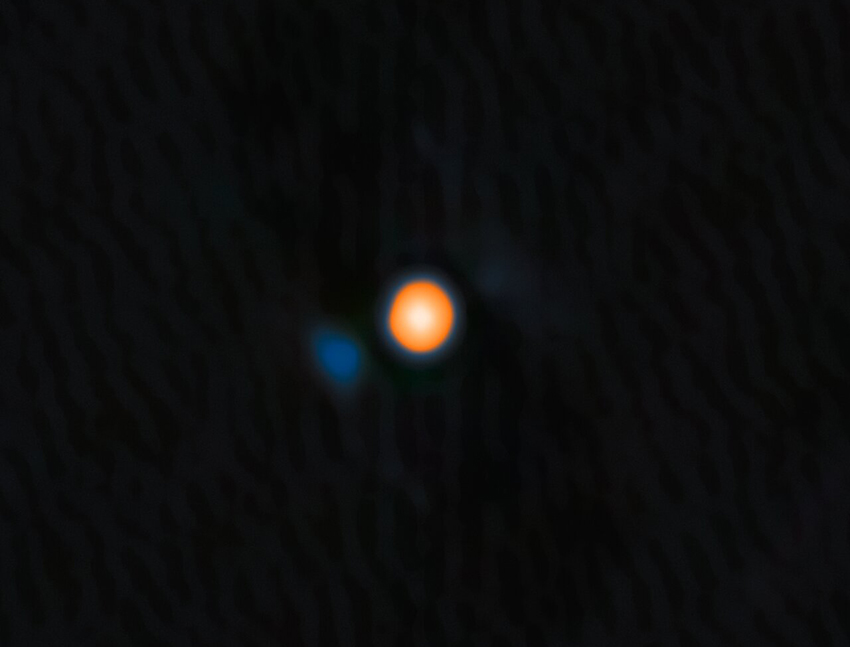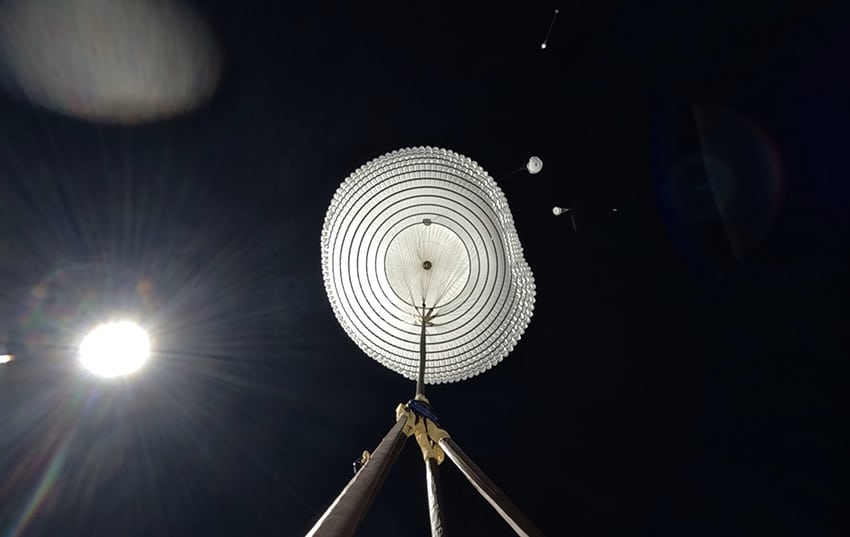Prestigious Appointment for Israeli Astronaut: This Week in Space
Israeli astronaut Eytan Stibbe was appointed Honorary President of the International Space University, a hidden companion star has been found near Betelgeuse, and ESA has successfully tested the massive parachutes for its future Mars rover. This Week in Space.
From the Space Station to the University
Private Israeli astronaut Eytan Stibbe has been appointed Honorary Chancellor of the International Space University (ISU). Founded in 1987, the university is a non-profit institution based in Strasbourg, France. Its mission is to advance space-related research and education and make them accessible to the broader public through courses and training programs, including its annual summer session, held each year in a different country.
The Honorary Chancellor is one of ISU’s three key leadership roles, alongside the Chairman and the President. Though largely ceremonial, it also carries strategic importance—advising university leadership, contributing to academic planning, fostering international partnerships, advancing educational and research initiatives, and supporting the university’s global community. Past holders of the title include legendary astronaut Buzz Aldrin, science fiction author Arthur C. Clarke, former ESA Director General Jean-Jacques Dordain, and renowned astrophysicist Pascale Ehrenfreund.
“A few months ago, I was approached about the role,” Stibbe told the Davidson Institute website. “I reviewed the academic programs, executive space courses, and intensive specializations, and felt I could contribute meaningfully to the university’s strategic direction in the years ahead. I went through several interviews with ISU’s executive leadership and space professionals before the appointment was unanimously approved. I recognize that this wasn’t a simple decision—especially at a time when Israel faces international challenges to its image. The fact that an Israeli was appointed to such a position underscores how space continues to bring nations together, even when politics pulls them apart.”
The position is voluntary but offers the opportunity to help shape the university’s strategic direction. “Key goals include expanding public engagement with space, promoting international collaboration and partnerships, strengthening ties between governments and the private sector, and ensuring academia remains at the forefront of space exploration” Stibbe said. “It’s also important to make space accessible not only to science and engineering, but to the humanities, arts, and other disciplines as well.”
“Israel has a strong connection to ISU,” he continued. “There are about 150 ISU alumni in Israel, many of whom remained in the space sector. This serves as a strong showcase of the country’s capabilities in both the private and public sectors.”
Stibbe, who flew as a private astronaut in 2022 on Axiom Space’s first mission (AX-1)—part of the company’s vision to build a commercial space station—is the first private astronaut ever appointed to such a senior role at ISU. “I believe appointing a private astronaut sends a strong message,” he said. “It reflects the ongoing transformation in the space sector. Take Axiom’s recent AX-4 mission, for example—the astronauts on board conducted a large number of experiments, far more than the regular crew can typically manage due to growing operational demands.”
As a private astronaut, Stibbe self-funded his spaceflight, reportedly paying Axiom around $50 million to join the mission. However, he dedicated his time in space to a public-benefit initiative called Rakia. Developed in collaboration with the Ramon Foundation, the mission featured dozens of scientific experiments—well beyond what was typical for a single astronaut at the time—as well as a range of educational and artistic projects.The Rakia has since become a public-benefit corporation, with Stibbe officially listed as a director and continuing to play a leading role in its activities.
“We’re deeply engaged in promoting space activity—building international collaborations, supporting Israeli space missions, and helping launch Israeli experiments into orbit,” he emphasized. “We’re also working toward sending another Israeli astronaut—possibly a woman—into space. At the same time, we’re expanding the Israeli Space Forum, which we lead, operating student space clubs in collaboration with the Israeli Space Agency, and advancing space education through the Ramon Foundation.”
“Eytan Stibbe brings a remarkable blend of experience, vision, and passion for space exploration—qualities that align perfectly with the values of the International Space University,” said ISU President John Wensveen. “We are honored to welcome him to this leadership role.”
As Honorary Chancellor of the International Space University, 67-year-old Stibbe hasn’t let go of his dream of returning to space. “If I had the opportunity—I’d go tomorrow,” he said. “But it would be great if someone else from Israel had the chance to have that experience.”

Working to send another Israeli astronaut into space. Eytan Stibbe on his way to the ISS during the AX-1 mission. Photo: Rakia Mission
Betelgeuse’s Hidden Companion
The star Betelgeuse is one of the brightest in the night sky. Easily visible to the naked eye, it has been known to humanity for thousands of years. Betelgeuse is a red supergiant that has expanded to an enormous size after exhausting the hydrogen in its core and beginning to fuse helium. Our own Sun is expected to undergo a similar transformation in a few billion years. Today, Betelgeuse is so massive it would engulf the entire inner solar system — extending beyond the orbit of Mars.
Thanks to its striking brightness and prominence, Betelgeuse has captivated astronomers for centuries. More than a thousand years ago, observers noticed a curious phenomenon: the star’s brightness regularly dims and brightens in a repeating six-year cycle.
This cycle is unrelated to the sudden dimming observed about five years ago, which led to speculation—and some hope—that Betelgeuse was on the verge of exploding in a supernova. That dimming was later attributed to material ejected by the star that condensed into dust and temporarily obscured it.
The consistent six-year variation led some scientists to hypothesize that Betelgeuse might be part of a binary system, with a companion star orbiting alongside it. However, observations by the Hubble Space Telescope and the Chandra X-ray Observatory failed to detect any nearby companion.
Undeterred by the lack of earlier evidence, astrophysicist Steve Howell of NASA’s Ames Research Center and his team turned to the Gemini North Telescope in Hawaii in search of the elusive companion. The telescope is equipped with an instrument capable of ultra-short exposure imaging, which minimizes atmospheric distortion. By combining this technique with the telescope’s high angular resolution, Howell and his team succeeded in capturing the first direct image of Betelgeuse’s companion and analyzing its properties.
The team concluded that the companion is a hot, blue-white star with a mass about 1.5 times that of our Sun. It orbits Betelgeuse at a relatively close distance of roughly 600 million kilometers—the closest a companion has ever been observed to a red supergiant. Although both stars are roughly the same age—around 10 million years—Betelgeuse is already nearing the end of its life, while its companion is just beginning and has yet to start fusing hydrogen.
Still, the companion may not have a long future either. The significant mass difference between the two could eventually cause Betelgeuse to tear its companion apart and absorb it, possibly within the next 10,000 years. For those unwilling to wait that long, there’s good news: according to the researchers, in November 2027, the two stars will reach maximum angular separation as seen from Earth — offering a better opportunity to capture more detailed images of the elusive companion.
“Papers that predicted Betelgeuse’s companion believed that no one would likely ever be able to image it,” said Howell. “This detection was at the very extremes of what can be accomplished with Gemini in terms of high-angular resolution imaging, and it worked. This now opens the door for other observational pursuits of a similar nature.”

International Gemini Observatory/NOIRLab/NSF/AURA, Image Processing: M. Zamani (NSF NOIRLab)
Europe Takes Off
The European Space Agency (ESA) has selected five rocket launch companies to advance in a program aimed at increasing Europe’s independence in launching small- and medium-sized payloads into space. Each company is eligible for grants of up to $200 million over the next three years to develop their launch vehicles and provide launch services for ESA missions.
The selected companies include two from Germany—Isar Aerospace and Rocket Factory Augsburg (RFA)—along with Maiaspace from France, PLD Space from Spain, and Orbital Express Launch from the UK, also known as Orbex.
Both German companies have made it to the launch pad but have yet to reach orbit. Isar Aerospace’s Spectrum rocket crashed just 30 seconds after its maiden launch in March 2025, while RFA suffered a rocket explosion during a static engine test in August 2024. In contrast, PLD Space successfully carried out a suborbital flight in 2023.
ESA hopes the program will enable European firms to better compete in a launch market currently dominated by U.S. companies and increasingly challenged by rising competition from China.

Boosting Europe’s launch independence. Isar Aerospace’s Spectrum rocket during its debut launch from Norway in March 2025, which ended in a crash seconds after liftoff. Photo credit: Isar Aerospace
Rosalind’s Mars Parachute
The European Space Agency (ESA) has successfully tested the parachutes intended to land its Mars rover on the Red Planet in about three years. In a trial conducted in northern Sweden, a dummy payload was lifted to an altitude of approximately 30 kilometers using a helium balloon and then released. A 15-meter drogue chute deployed first, followed by a massive 35-meter main parachute. Made of over 800 square meters of fabric, with suspension cords totaling more than four kilometers in length, it is expected to be the largest parachute ever used on Mars—or anywhere else.
Mars’s atmosphere is only about 1.5% as dense as Earth’s, but the test incorporated several factors to simulate Martian landing conditions—including high entry speeds following a relatively long free fall and parachute deployment in the stratosphere, where Earth’s air is extremely thin.
The Rosalind Franklin Mars rover—named after the British female scientist whose X-ray crystallography work was instrumental in the deciphering of the double helical structure of DNA—is designed to search for signs of ancient life on Mars.Its development has spanned more than a decade and has faced multiple delays. Originally a joint mission with Russia, the rover was scheduled to launch aboard a Russian rocket in 2020 but was postponed due to technical issues. Following Russia’s 2022 invasion of Ukraine, ESA terminated the partnership. The completed rover was placed in storage until last year, when Thales Alenia Space won an ESA contract to refit the rover and prepare the remaining mission components.
Now, the mission’s future hinges on decisions in Washington. NASA has joined the program and agreed to fund the launch—at a cost of several hundred million dollars. However, earlier this year, the U.S. administration announced sweeping budget cuts to NASA, including the cancellation of several science missions. Last week, though, the Senate Appropriations Committee rejected parts of the proposed cuts, leaving hope that the U.S. will move forward with funding the launch, allowing the European rover to finally roll across the Martian surface

Passed the test. The main parachute for Europe’s Mars rover deployed successfully during a trial in northern Sweden. Photo credit: Vorticity






